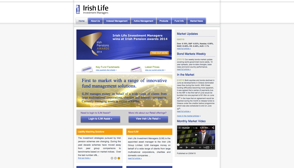An option available to you at retirement is to invest your pension fund in an Approved Retirement Fund (ARF). ARFs are special investment funds which can give you increased flexibility in terms of how you use your pension fund after retirement.
With an ARF you manage and control your pension fund. You can be happy in the knowledge that you can withdraw as much of this as you wish, should you ever need to. Any withdrawals you take from your ARF will be subject to income tax*, the Universal Social Charge and PRSI (if you are liable for this). In the meantime the fund will continue to be invested in funds of your choice.
*These amounts and the valuation dates may change as specified by the Government. The information is correct as at February 2022.
To find out whether you have the option at retirement to invest in an ARF please talk to your Financial Advisor.
Important points to consider before buying an ARF
WARNING: The value of your investment may go down as well as up.
In all other cases, the funds are wound up and the proceeds are passed to your estate. If your estate has to pay income tax, we must take this before paying the proceeds of your fund to your estate.
Your tax advisor will be able to advise you on the Capital Acquisition Tax (Inheritance Tax) implications which may apply also.
A summary of the tax rules after your death (based on rates at February 2022).
| ARF inherited by | Income Tax due | Capital Acquisitions Tax due |
|---|---|---|
| Surviving spouse/civil partner | No tax due on the transfer to an ARF in the spouse's/civil partner's name. | No |
| Children (under 21) | No tax due | Yes* |
| Children 21 and over | Yes (30%) | No |
| Others (including surviving spouse/civil partner if benefit paid out as a lump sum) | Yes, at deceased's tax rate at the time of death (either 20% or 40%) | Yes* |
*Normal Capital Acquisitions Tax thresholds apply.
*Tax on any withdrawals is deducted as per the tax certificate submitted to us or in other cases at the marginal tax rate (40% as of February 2022).
WARNING: The income you get from this investment may go down as well as up.
What are the disadvantages of an ARF?
Investing in funds
Depending on which fund you invest in, its value can fall as well as rise over the period of your investment. We recommend that you consider an ARF as an investment for at least five years or more. In general, the longer you leave your investment, the better it is likely to perform. By choosing a low-risk fund, you are protecting any gains you make over the period of investment. However, the potential for large gains is lower than if you choose a high-risk fund.
High-risk funds mainly invest in company shares so their value is not protected but you do have the potential to gain significantly, especially over the long term. If you invest in these funds you should realise that, in wanting a higher return, you could lose some of the value of your investment. If you decide to take a regular income from your ARF and the investment growth is lower than the level of income you have chosen, this will reduce your original investment.
Consider the risks associated with investing. Everyone's situation is different, and everyone handles risk differently. With the help of your pension contact, you are the best person to decide how much risk you are comfortable with.
Imputed distribution
One of the rules governing ARFs is that tax, Universal Social Charge and PRSI (if you are liable for this) must be deducted as if income were taken, even if no income is taken in a particular tax year. Below we explain how this is applied to an ARF.
- From the year you turn 61, tax is payable on a minimum withdrawal on the 30 November* each year of 4% of the value of the fund at that date. This withdrawal is liable to income tax, Universal Social Charge and PRSI (if you are liable for this). From the year you turn 71 the minimum withdrawal is increased to 5%.
- Where the fund value is greater than €2 million the minimum withdrawal will be 6%. If you have more than one Approved Retirement Fund (ARF) and these are with different managers then you must appoint a nominee Qualified Fund Manager (QFM) who will be responsible for ensuring a withdrawal of 6% is taken from the total value of your ARFs. It is your responsibility to let your ARF providers know if you have other Approved Retirement Funds and Vested Personal Retirement Savings Accounts with a total value of greater than €2 million.
- Where a greater withdrawal is made during the year, tax will be paid on the greater withdrawal amount. The minimum withdrawal rate is set in line with the required imputed distribution amount which may be altered to reflect changes in legislation. You can choose to take a higher withdrawal amount if you wish.
- You should seek advice on whether it is appropriate to draw down the 4%/5% or 6% of your fund value.
- Annual imputed distribution reduces the benefit of gross roll up**.
*These amounts and the valuation dates may change as specified by the Government. The information is correct as at February 2022.
**The investments are allowed to grow tax-free until such time as an event happens which incurs a tax liability, known as a chargeable event.
More Information
For more information please contact your company pension advisor, your broker, or Irish Life Sales Support on (01) 704 2000 or email Happytohelp@irishlife.ie
WARNING: The value of your investment may go down as well as up.
WARNING: This product advice may be affected by changes in currency exchange rates.
WARNING: The income you get from this investment may go down as well as up.
WARNING: If you invest in this product you may lose some or all of the money you invest.
The assets in these funds may be used for the purposes of securities lending in order to earn an additional return for the fund. While securities lending increases the level of risk within the fund it also provides an opportunity to increase the investment return.



